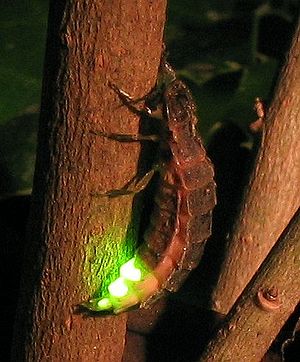Big firefly
| Big firefly | ||||||||||||
|---|---|---|---|---|---|---|---|---|---|---|---|---|

Female of the Great Firefly |
||||||||||||
| Systematics | ||||||||||||
|
||||||||||||
| Scientific name | ||||||||||||
| Lampyris noctiluca | ||||||||||||
| ( Linnaeus , 1767) |
The large firefly or large glow worm or large St. John's glow worm ( Lampyris noctiluca ) is a beetle from the firefly family (Lampyridae).
features
The males are 10 to 12 millimeters long. Your body is brown, the edges of the front, rounded, pointed back at the corners of the neck plate are yellowish. The head is hidden under the pronotum. The wing covers have three to four longitudinal ribs, their surface is finely roughened and loose, hairy short. At the seventh sternite there is a weakly visible light field. You are winged.
The females are 15 to 20 millimeters long. They have a red-brown body and resemble a larva in their shape. The edge of the pronotum is the same as that of the individual body segments and the midline, along the abdomen, yellowish. A scutellum is not formed. There are light fields on the sixth and seventh segment and luminous spots on the eighth segment. They are completely wingless and also have no wing stumps.
The species can be confused with the small firefly ( Lamprohiza splendidula ). The males of the great firefly differ in the lack of transparent windows on the pronotum, the females in the lack of the wing-cover stumps.
Occurrence
The species is widespread in Europe and Asia and occurs in the north to the south of Norway and central Sweden and Finland. In the south, the distribution also includes the Mediterranean area. The species is locally distributed in the British Isles . It populates the edges of forests and meadows, but also gardens and parks, from the lowlands to the foothills. In the Swiss Alps, the species has been detected at altitudes of around 1800 meters. The flight time is from June to September.
Way of life
The animals are crepuscular and nocturnal. Males fly around looking for females, who sit on the ground and draw attention to themselves with lights. The males shine only weakly in comparison to them. The males do not eat any food. The larvae predatory feed on slugs and snails. These are killed by a poison bite. The larvae take two to three years to develop. The adult beetles appear between May and July. The female dies shortly after laying eggs. The time until the larvae hatch depends on the weather and lasts between 27 and 45 days.
threat
Fireflies are endangered by the use of pesticides , slug control and light pollution and are in decline almost everywhere. In 2019, the firefly was voted Animal of the Year in Switzerland .
supporting documents
literature
- Karl Wilhelm Harde, Frantisek Severa and Edwin Möhn: The Kosmos Käferführer: The Central European Beetles. Franckh-Kosmos Verlags-GmbH & Co KG, Stuttgart 2000, ISBN 3-440-06959-1 .
- Jiři Zahradnik, Irmgard Jung, Dieter Jung et al .: Beetles of Central and Northwestern Europe. Parey, Berlin 1985, ISBN 3-490-27118-1 .
- Georg Möller, Reiner Grube, Ekkehard Wachmann : The Fauna Käferführer I - Beetles in and on the forest Fauna-Verlag, Nottuln 2006, ISBN 3-935980-25-6 .
Web links
Individual evidence
- ↑ Animal of the Year 2019 - The firefly is supposed to focus on the location of the insects. In: srf.ch . January 3, 2019, accessed June 22, 2019 .


